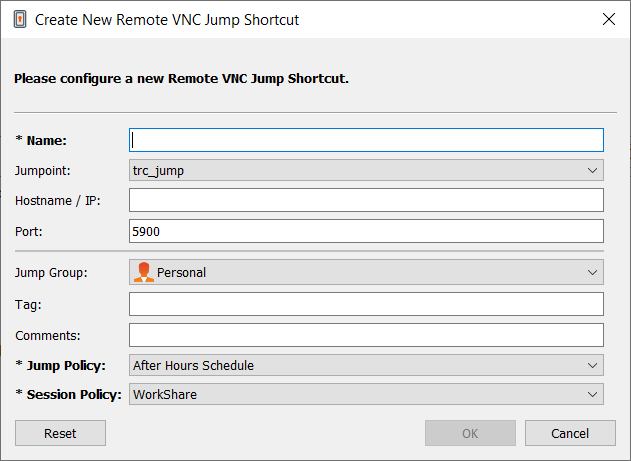Use VNC to Access a Remote Windows Endpoint
Use BeyondTrust to start a VNC session with a remote Windows or Linux system. Because VNC sessions are proxied through a Jumpoint and converted to BeyondTrust sessions, users can share or transfer sessions, and sessions can be automatically audited and recorded as your administrator has defined for your site. To use VNC through BeyondTrust, you must have access to a Jumpoint and have the user account permission Allowed Jump Methods: Remote VNC via a Jumpoint.
Create a VNC Shortcut
To create a VNC shortcut, click the Create button in the Jump interface. From the dropdown, select Remote VNC. VNC shortcuts appear in the Jump interface along with Jump Clients and other types of Jump Item shortcuts.
Enter a Name for the Jump Item. This name identifies the item in the session tabs. This string has a maximum of 128 characters.
From the Jumpoint dropdown, select the network that hosts the computer you wish to access. The access console remembers your Jumpoint choice the next time you create this type of Jump Item.
Enter the Hostname / IP of the system you wish to access.
By default, the VNC server listens on port 5900, which is, therefore, the default port BeyondTrust attempts. If the remote VNC server is configured to use a different port, add it after the hostname or IP address in the form of <hostname>:<port> or <ipaddress>:<port> (e.g., 10.10.24.127:40000).
Move Jump Items from one Jump Group to another using the Jump Group dropdown. The ability to move Jump Items to or from different Jump Groups depends upon your account permissions.
Further organize Jump Items by entering the name of a new or existing Tag. Even though the selected Jump Items are grouped together under the tag, they are still listed under the Jump Group in which each Jump Item is pinned. To move a Jump Item back into its top-level Jump Group, leave this field blank.
Jump Items include a Comments field for a name or description, which makes sorting, searching, and identifying Jump Items faster and easier.
To set when users are allowed to access this Jump Item, if a notification of access should be sent, or if permission or a ticket ID from your external ticketing system is required to use this Jump Item, choose a Jump Policy. These policies are configured by your administrator in the /login interface.
Use a VNC Shortcut
To use a Jump shortcut to start a session, select the shortcut from the Jump interface and click the Jump button.
When establishing the connection to the VNC server, the system prompts you to enter the user name and password.
Your VNC session now begins. Begin screen sharing to view the remote desktop. You can send the Ctrl-Alt-Del command, capture a screenshot of the remote desktop, and share clipboard text contents. You also can share, transfer or record the VNC session, following the normal rules of your user account settings.
Jump Items can be set to allow multiple users to simultaneously access the same Jump Item. If set to Join Existing Session, other users are able to join a session already underway. The original owner of the session receives a note indicating another user has joined the session, but is not allowed to deny them access. For more information on simultaneous Jumps, please see Jump Item Settings.

